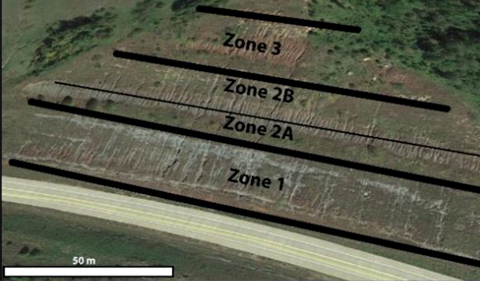
Outcrop studied by Hembree and Carnes with climatically influenced soil zones labeled
Dr. Daniel Hembree, Professor of Geological Sciences, and former graduate student Jennifer Carnes M.S. ’17 recently published “Response of soils and soil ecosystems to the Pennsylvanian–Permian climate transition in the upper fluvial plain of the Dunkard Basin, southeastern Ohio, USA” in the open access journal Geosciences.
In this study, Hembree and Carnes investigated approximately 300 million-year-old fossil soils from roadcuts along Ohio Route 33 in Meigs County, Ohio. These soils formed over the span of 2 to 5 million years across the Pennsylvanian-Permian boundary during which time regional climate was shifting to more seasonal and drier conditions. The goal of the study was to determine the effects of this climatic transition on soils and the organisms that lived within them.
The results of the project indicated that the soils, plants, and animal changed significantly over the studied interval. The types of soils present (soil orders) and communities of soil organisms changed quickly in response to variations in the amount and annual distribution of precipitation. These changes resulted in very different landscapes in Ohio from the end of the Pennsylvanian to the beginning of the Permian.
Abstract: Direct exposure of paleosols to the atmosphere during formation make them ideal for reconstructing paleoclimate. Paleosol and ichnofossil properties are dependently linked making it important to study them in tandem, to avoid errors in interpretation. Small scale studies (<1 km) yield high resolution data that can be used to assess allogenic processes through comparison of spatial and temporal trends. This study used field and laboratory analyses to gather data from Late Pennsylvanian to Early Permian Upper Monongahela and Lower Dunkard group paleosols on Ohio Route 33 in Meigs County, OH, USA. The physical and geochemical properties of the paleosols from the field sites indicate that channel migration was the primary control on paleosol formation in the study area, however, a clear climate signal was observed. The change in paleosol type and calculated mean annual precipitation (MAP) values indicate that the climate became more strongly seasonal and drier over the course of the Pennsylvanian–Permian transition with a temporary excursion to a more ever-wet climate with higher MAP, marked by the occurrence of the Waynesburg Coal at the Pennsylvanian–Permian boundary.



















Comments